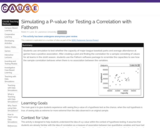
- Subject:
- Psychology
- Material Type:
- Unit of Study
- Provider:
- Rice University
- Provider Set:
- OpenStax College


By the end of this section, you will be able to:
Explain what a correlation coefficient tells us about the relationship between variables
Recognize that correlation does not indicate a cause-and-effect relationship between variables
Discuss our tendency to look for relationships between variables that do not really exist
Explain random sampling and assignment of participants into experimental and control groups
Discuss how experimenter or participant bias could affect the results of an experiment
Identify independent and dependent variables


This activity has students use Fathom to test the correlation between attendance and ballpark capacity of major league baseball teams by taking a sample of actual data and scrambling one of the variables to see how the correlation behaves when the variables are not related. After displaying the distribution of correlations for many simulated samples, students find an approximate p-value based on the number of simulations that exceed the actual correlation.

Students are introduced to the technology of flexible circuits, some applications and the photolithography fabrication process. They are challenged to determine if the fabrication process results in a change in the circuit dimensions since, as circuits get smaller and smaller (nano-circuits), this could become very problematic. The lesson prepares students to conduct the associated activity in which they perform statistical analysis (using Excel® and GeoGebra) to determine if the circuit dimension sizes before and after fabrication are in fact statistically different. A PowerPoint® presentation and post-quiz are provided. This lesson and its associated activity are suitable for use during the last six weeks of the AP Statistics course; see the topics and timing note for details.

This video explains the different types of study designs used in statistics. [9:51]
Khan Academy learning modules include a Community space where users can ask questions and seek help from community members. Educators should consult with their Technology administrators to determine the use of Khan Academy learning modules in their classroom. Please review materials from external sites before sharing with students.

This page gives a lot of informaiton on correlation, including a section on the coefficient of correlation.

This tutorial takes you through the steps of creating a scatter plot, drawing a line-of-fit, and determining the correlation if any. [1:40]

This tutorial takes you through the steps of creating a scatter plot, drawing a line-of-fit, and determining if there is any correlation. [1:56]

This tutorial takes you through the steps of creating a scatter plot, drawing a line-of-fit, and determining the correlation if any. [1:53]

Learn about no correlation and see how to tell if data shows no correlation by watching this tutorial. [1:07]

Learn about line-of-fit, negative slope, and negative correlation by watching this tutorial. [1:02]